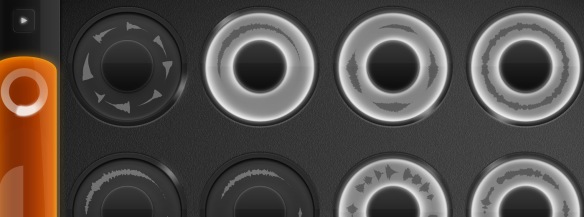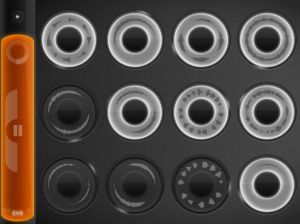 As I’ve noted in previous posts, a core aspect of my honours year project is based upon the idea of extending ‘vertical’ aspects of sound (borrowing from Eric Tamm’s observations of Brian Eno’s approach to music creation), insofar as using timbre and texture as a source for music creation, rather than a linear, time-based approach. Although our perception of music in the broadest sense is usually based upon a series of sound events occurring over a given period, I believe it’s entirely possible to create the impression of time being ‘suspended’ – as I’ve previously suggested, the use of quartal harmony, drone and the use of repetition all go some way to creating a feeling of suspension in music. What I haven’t discussed in great detail up until this point is my working methodology, which is integral to this process and which I have only arrived at through through a degree of trial and error, from trying out several different compositional approaches and software applications.
As I’ve noted in previous posts, a core aspect of my honours year project is based upon the idea of extending ‘vertical’ aspects of sound (borrowing from Eric Tamm’s observations of Brian Eno’s approach to music creation), insofar as using timbre and texture as a source for music creation, rather than a linear, time-based approach. Although our perception of music in the broadest sense is usually based upon a series of sound events occurring over a given period, I believe it’s entirely possible to create the impression of time being ‘suspended’ – as I’ve previously suggested, the use of quartal harmony, drone and the use of repetition all go some way to creating a feeling of suspension in music. What I haven’t discussed in great detail up until this point is my working methodology, which is integral to this process and which I have only arrived at through through a degree of trial and error, from trying out several different compositional approaches and software applications.
What was impressed upon me early in this investigation was that in exploring timbral qualities, the use of notation was perhaps not advisable, insofar as detailing musical ideas – it would be difficult for example, to notate a guitar with a number of audio effects applied, such as reverb, reverse echo and phasing. As I’m looking equally at the quality of sound as well as pitch material in music composition, or more specifically a phenomenological approach to sound, using conventional notation seems cumbersome and limited. What became apparent in adopting this approach to sound, that not only would a recording technology necessarily be my prime compositional tool, but preferably also one that somehow negated, or at least relegated a sense of time passing. As readers would be aware, most modern recording software such as Avid Pro Tools and Apple’s Logic and Garageband employ a window-based interface with a time line, usually scrolling from left to right – it’s aimed principally at recording engineers, and although simplified for the domestic market (as in Garageband) these interfaces are both visibly crowded and make the user constantly aware of a time-based approach, in keeping with conventional recording practices. There are numerous editing tools, controllers, menus and plug-ins competing for your attention, and what I often found was once an idea was recorded (after the rigmarole of plugging in iLoks, connecting an audio interface and booting up the software), there was a tendency to try to make the recording ‘sound better’, by using effects plug-ins, or editing a sound with various tools, or employing time-stretching or pitch-correction – the sound could not be accepted for its own intrinsic quality and had to ‘fixed’ somehow. This tendency to ‘fiddle’ also tended to kill off any creativity fairly quickly and I found myself mostly frustrated and irritated by the process. Although an experienced Pro Tools user for the last ten years, I was finding that a different approach to composition required a different type of technology, and I was in a way yearning for the simplicity of the tape-based recording methods I had use back in my art-school days. Enter Loopy…
Loopy is an iPad and iPhone based app that employs a simple interface consisting of a series of circular ‘loops’ – to record a sound, you simply tap one of the circles, and when you’re finished, simply tap again – the waveform of the sound appears in the circle as it records, with each loop ending up looking somewhat like a peppermint Life Saver. Being loop-based, the recorded sound simply cycles around and around – it can be as short or as long as you wish. Many musicians use loop stations to lay down repetitive elements in music, such as rhythm tracks and simple harmonic structures that exploit the synchronised features of the application, usually so users can improvise a performance over the top, and the loop station effectively operates as a self-made backing track for performance. However, the most attractive element to me of Loopy apart from its visual interface and simplicity, is that it can also record unsynchronised – this feature alone is worth its weight in gold. You may wonder at this point why on earth I would wish to unsynchronise each track – surely I would wish each track to be in time with each other? Well, no…
Part of the attraction of the Brian Eno approach to music creation is allowing for music elements to evolve gradually, almost imperceptibly over time. Eno uses a number of methods to bring this about, but principle among these is the tape-based approach that he employed with Robert Fripp in the making of No Pussyfooting (1973), developed further on Discreet Music (1975), his initial foray into ‘ambient’ music. Utilising two tape recorders, Eno created a tape delay system that repeated elements at varied lengths of time, continuously overlapping and reconfiguring in myriad combinations to create random generations of the original source material. Although repetitive in nature, no one point in a piece is exactly like another; musical interest is generated by placing emphasis on both the repeated sound itself and upon the phenomena it arouses, holding the listener in a kind of suspension: the effect can be mesmerising. This ‘generative’ approach would be developed by Eno in the ensuing years in a number of forms, but I have have used this as both a source of inspiration and a method to use in conjunction with Loopy, which in many ways is already set up for this purpose.
As Loopy is inherently designed to repeat elements over and over, and by de-synchronising its tracks, it allows me to create music in a way that approaches Eno’s methodology. By using a combination of short and longer loops, and by using quartal harmony as a template, I’m finally beginning to bring about some of the ideas that have existed only in my head up until this point. Using a combination of ‘found’ environmental sounds, mixed with instrumental improvisations based on quartal motifs, I’m beginning to find the ephemeral, timeless and ‘spectral’ quality that I’ve been looking for. Using Loopy in conjunction with Audiobus, which allows you to ‘chain’ sound generating devices and effects together, I can introduce audio effects such as reverberation, echo and phasing to introduce new textural possibilities and further remove sounds from their original context, building on a phenomenological approach. The simplified interface allows me to start recording virtually straight away – I can use the internal microphone or plug into an audio interface via the lightning connector, and be ready to go within seconds, without all the visual clutter and myriad buttons and choices of Pro Tools or Logic.
For sheer spontaneity, it’s a magical application to have, and for this particular project, improvisation and spontaneity are paramount to the creative process. This is not a project of contemplation, though the process itself has been: this is a project born of creating a mood or feeling on a particular morning or afternoon and working with the materials I have available to me at any given time. And all this on an iPad, with very little external equipment – it can be done with as little as the iPad itself and a pair of headphones.
I’ll be posting a number of my efforts as I go, but you can hear some of the initial experiments here: these are all works in progress, but I’m pleasantly surprised by what I’ve come up with so far. All are based on quartal four note clusters, hence the titles:
https://soundcloud.com/peter-g-long/sets/spectral-compositions
Enjoy… more discoveries as they come to hand.

